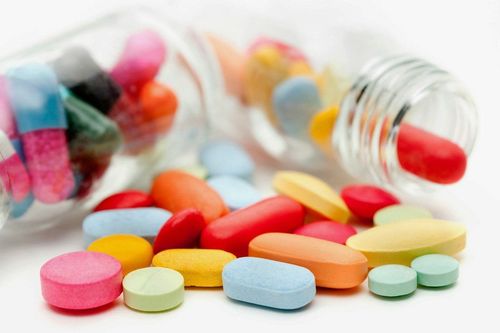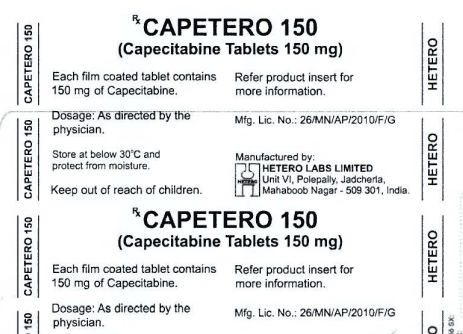This is an automatically translated article.
Capelodine contains the main ingredient is Capecitabine with a strength of 500mg - one of the groups of cancer chemotherapy drugs. Drugs that work on the body's immune system and destroy or fight cancer cells. Some cancer diseases have indications for Capelodine treatment such as colon cancer, rectal cancer, stomach cancer, breast cancer,...
1. Capelodine medicinal uses
Drugs are used for the main purpose of treating certain cancers. Can be used alone or in combination with other chemotherapy drugs. Drugs that kill or inhibit the growth of cancer cells, thereby reducing the size of the tumor.
Capecitabine is a fluoropyrimidine carbamate derivative that is selectively toxic to tumor cells. Capecitabine will convert to 5-FU (5-fluorouracil) when entering the body. The formation of 5-FU in the tumor is optimally catalyzed by the tumor-associated angiogenic factor thymidine phosphorylase, thereby minimizing the extent of 5-FU-induced damage to healthy tissue.
The mechanism of drug toxicity on tumor cells is due to the following reasons:
FdUMP and folate cofactor N5-10-methylenetetrahydrofolate bind to thymidylate synthase to form a three-factor complex, thereby forming a covalent complex. inhibits the formation of thymidylate (a substance required for DNA synthesis) from uracil, leading to inhibition of cell division. Nuclear transcription enzymes may mistakenly incorporate FUTP instead of uridine triphosphate during RNA synthesis. This metabolic error can affect RNA and protein synthesis.
2. Instructions for using the drug Capelodine
Capelodine drug is indicated in some of the following cases:
Colorectal cancer: Adjuvant treatment after surgery or neoadjuvant before surgery or in combination with radiation therapy (concurrent chemoradiotherapy) or treatment provisional treatment in late stages, recurrence, progression, metastasis. May be used alone or in combination with other chemotherapy drugs. Breast cancer: Temporary treatment in late stage, recurrence, progression, metastasis. May be used alone or in combination with other chemotherapy drugs. Stomach cancer: Adjuvant treatment after surgery or provisional treatment in late stage, recurrence, progression, metastasis. May be used alone or in combination with other chemotherapy drugs. Bile and pancreatic cancer: Post-operative adjuvant treatment or provisional treatment in late stage, recurrence, progression, metastasis. May be used alone or in combination with other chemotherapy drugs. Should take the drug with water within 30 minutes after eating, drink the whole tablet, do not chew the tablet. Dosage depends on the type of cancer, as well as how to use it alone or in combination with other chemotherapy drugs:
Single treatment: 1250mg/m2 skin (oral), 2 times a day, continuously for 2 weeks. After that, take a week off, then start a new cycle. Maintenance therapy until disease progression or intolerance. Combination treatment: Combined with chemotherapy in colorectal cancer, stomach cancer: 1000mg/m2 of skin (oral), 2 times a day, continuously for 2 weeks. After that, take a week off, then start a new cycle. Treatment for 8 cycles (3 weeks apart with other chemotherapy drugs). Combined with radiotherapy in rectal cancer (in concurrent chemoradiotherapy): 800-825 mg/m2 skin (oral), 2 times daily, 5 days per week (on radiotherapy days). Breast cancer: 1000mg/m2 skin (oral), 2 times daily, continuously for 2 weeks. After that, take a week off, then start a new cycle. Maintenance therapy until disease progression or intolerance. Bile and pancreatic cancer: 650mg/m2 of skin (oral), twice daily, continuously for 2 weeks. After that, take a week off, then start a new cycle. Treatment for 6-8 cycles (3 weeks apart with other chemotherapeutic agents) for adjuvant or maintenance purposes until disease progression or drug intolerance for palliative purposes. For pregnant women and lactating women: Not to be used because the drug can completely be excreted in milk, affecting the baby and transported across the placenta, affecting the fetus. It is advisable to consult a specialist to consider the appropriate treatment. Before prescribing Capelodine, tell your doctor if you have one of the following contraindications:
Hypersensitivity to Capecitabine or other ingredients of the drug. Liver failure. CKD . Have blood diseases such as bleeding or clotting disorders. Anemia. Severe leukopenia. Severe thrombocytopenia. Deficiency of DPD enzyme. Never stop taking the medication on your own without consulting your doctor. Limit forgetting to take medication to ensure the effectiveness of treatment. If you miss a dose, take it as soon as you remember, but if it is almost time for the next dose, only take the dose at that time, do not combine doses to avoid side effects due to overdose.
Besides, the patient is not allowed to increase or decrease the dose on his own.
Use caution when using for people who work related to driving or operating machinery because the drug can affect concentration through side effects.
In elderly patients with many comorbidities, it is advisable to reduce the dose of the drug to avoid increased toxicity.
Do not tear the medicine packaging, store at a temperature below 30oC and in a dry place, protected from light. If the medicine shows signs of damage, deformation, color change, or watery discharge, the tablet should not be used anymore.
3. Drug interactions and side effects of Capelodine
3.1 Drug Interactions Capecitabine can cause serious interactions with the following drugs:
Mini anticoagulant. Phenytoin (antiepileptic drug). Antacids. Sorivudine and similar drugs (treatment of chickenpox and HIV infection). Allopurinol. Vitamin K antagonists 3.2 Side effects Possible side effects of Capelodine may include:
Nausea, vomiting. Anorexia, not eating well. Digestive disorders . Peripheral neuropathy. Hand-foot syndrome. Fatigue, feeling weak. Headache, dizziness, insomnia. Taste change. Hair loss. Mouth ulcers. Menstrual disorders. Infertility. Anemia. Most of the toxicity was mild and completely tolerable, there was no need to delay treatment. Rarely causes allergic reactions.
Although there are many side effects, research has found that the benefits of the drug outweigh the risks posed by the drug. Moreover, the doctor can prescribe some supportive drugs, as well as guide methods to calm the toxicity of the drug.













